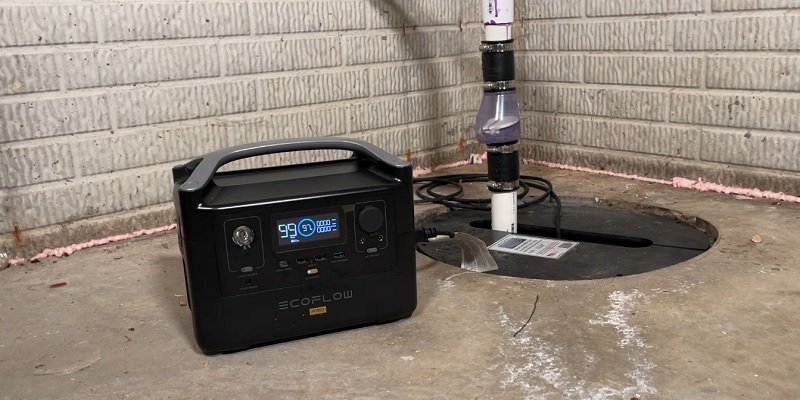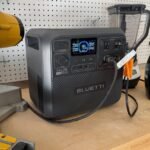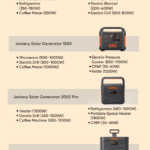Disclosure: This post contains affiliate links and I will be compensated if you make a purchase after clicking through my links. Learn More
Yes, portable power stations can run sump pumps when sized correctly for your specific pump’s power requirements.
Protecting your basement from flooding is a top priority for many homeowners. Sump pumps are reliable tools that keep water out of your basement, but they become useless during power outages. This is where portable power stations come in as potential backup solutions. Let’s explore whether these power stations can actually run your sump pump when you need it most.

Understanding Sump Pump Power Requirements
Sump pumps require specific amounts of power to work properly. Most residential sump pumps use 1/3 to 1/2 horsepower motors, which translates to different power needs in watts.
A typical 1/3 HP sump pump uses about 1300–1600 watts when starting up and 700–800 watts while running. A 1/2 HP pump needs around 2000–2500 watts at startup and 1000–1200 watts during operation. This difference between starting watts and running watts is crucial when picking a power station.
To figure out your sump pump’s exact needs, check the label on the pump or its manual. Look for:
- Horsepower (HP)
- Volts (V)
- Amps (A)
You can calculate watts by multiplying volts by amps. For example, a pump using 120V and 5A needs 600 watts.
Other factors affecting power use include pump type (submersible pumps often use more power than pedestal pumps), how much water needs to be pumped, and how high the water needs to be lifted (head height).
We recommend measuring the actual power draw with a wattage meter like a Kill-A-Watt. Many homeowners discover their pumps use more power at startup than manufacturers list. This real-world measurement helps ensure your power station can handle the load.
What Size Portable Power Station Do You Need?
For a sump pump, you need a portable power station that can handle both the startup surge and provide enough capacity for reasonable runtime.
As a general rule:
For 1/3 HP pumps: Look for at least 1600W output and 700–800Wh capacity
For 1/2 HP pumps: You need at least 2500W output and 1000–1200Wh capacity
For 3/4 HP pumps: Look for at least 3000W output and 1500–1800Wh capacity
For 1 HP pumps: You need at least 3500W output and 1800–2200Wh capacity
The 1/3 HP sump pump is the most common size found in residential homes. These pumps typically draw between 700–800 watts during normal operation but can surge to 1300–1600 watts during startup. The 1/2 HP models are used in homes with more substantial water issues, drawing 1000–1200 watts running and surging to 2000–2500 watts. The larger 3/4 HP and 1 HP pumps are typically found in commercial settings or homes with severe water problems.
The formula we use:
Minimum Power Station Size (W) = (Startup Watts × 1.2)
This gives you a 20% safety margin, which is important for the health of your power station and reliable pump operation.
For capacity (measured in Watt-hours or Wh), calculate:
Minimum Capacity = (Running Watts × Hours of Operation Needed)
If your 1/3 HP pump uses 750W while running, and you want 4 hours of backup, you need:
750W × 4h = 3000Wh minimum capacity
In real-world scenarios, a sump pump doesn’t run continuously. It cycles on and off as needed. If your pump runs 3 minutes every 10 minutes during heavy rain (30% duty cycle), your actual runtime would be much longer.
How Long Will a Portable Power Station Run Your Sump Pump?
Runtime depends on power station capacity, pump power needs, and duty cycle. Here’s the formula for calculating runtime:
Runtime (hours) = (Power Station Capacity × Efficiency Factor) ÷ (Running Watts × Duty Cycle)
The efficiency factor (usually 0.85–0.9) accounts for power conversion losses.
Example: A 1500Wh power station running a 750W pump with a 30% duty cycle.
Runtime = (1500Wh × 0.9) ÷ (750W × 0.3) = 1350 ÷ 225 = 6 hours
During storms, actual runtimes vary based on rainfall. In heavy downpours, your pump might run more often, reaching a 50% duty cycle or higher. With this duty cycle, the same setup would last only about:
Runtime = (1500Wh × 0.9) ÷ (750W × 0.5) = 1350 ÷ 375 = 3.6 hours
Weather patterns affect runtime. During gentle rain followed by clearing, the duty cycle might start high and gradually drop, extending your runtime. Power stations with monitoring features help track power use and show remaining runtime.
Temperature affects battery performance too. In cold basements (below 40°F/4°C), lithium battery capacity can drop by 20% or more. If your basement gets cold during outages, keep your power station in a warmer spot until needed.
Best Portable Power Stations for Sump Pumps

The best power stations for sump pumps share key features:
- Pure sine wave output (essential for motor-driven appliances)
- High surge capacity (at least 2× the continuous rating)
- Adequate battery capacity
- Multiple AC outlets
- Reliable battery management system
Based on extensive testing and real-world use, these power stations work well with sump pumps:
EcoFlow DELTA 3 Classic works well for 1/3 HP sump pumps. It has 1800W output and 3600W surge capacity, easily handling startup surges. Its 1024Wh capacity gives about 1.16 hours of continuous operation for a typical 750W running sump pump, or about 3.87 hours at a 30% duty cycle. The DELTA 3 Classic charges fast, reaching 80% capacity in 45 minutes.
The Bluetti Elite 100 V2 provides 1800W output and 1024Wh battery storage. It works well for 1/3 HP pumps and has enough capacity for longer outages. The Bluetti Elite 100 V2 uses LiFePO4 batteries for longer life (over 4000 charge cycles). Its built-in monitoring system shows how much power your pump is using and calculates remaining runtime.
Jackery Explorer 1000 Plus offers 2000W output with 1264Wh capacity, good for 1/3 HP pumps. While it charges slower than EcoFlow models, it’s reliable and user-friendly. The Explorer 1000 Plus can run a typical 1/3 HP (~750W) pump for about 1.43 hours continuously or 4.77 hours at a 30% duty cycle.
For 1/2 HP pumps, the EcoFlow DELTA Pro has 3600W output and 3600Wh capacity. This unit handles larger pumps easily and provides long runtime during outages. The DELTA Pro can use extra battery packs and can integrate into home circuits with optional accessories.
The Bluetti Elite 400 combines 2600W output with a large 3840Wh capacity. Its output is lower than the DELTA Pro, but its bigger capacity works well for extended outages. It can run a 1/3 HP pump for days during a power outage, depending on duty cycle. The Elite 400 UPS function switches automatically when power fails, reducing flooding risk if you’re not home.
Jackery Explorer 2000 Plus has 3000W output with 2042Wh capacity. It can run a 1/3 HP (~750W) pump for about 2.31 hours continuously or 7.68 hours at a 30% duty cycle. It’s rugged and reliable but lacks the expandability of EcoFlow and Bluetti models.
These units provide enough power and capacity to run sump pumps effectively during outages.
When choosing a power station for your sump pump, focus on surge capacity first, then battery capacity. If a unit can’t handle your pump’s startup surge, it won’t work regardless of battery size.
Which Brand Should I Choose
Every Brand has some unique features:
EcoFlow units feature X-Boost technology that can temporarily handle loads exceeding their rated continuous output. This provides extra headroom for handling startup surges from sump pumps. They also offer expandability options, allowing you to connect additional battery modules for extended runtime during prolonged outages.
A particularly valuable feature in EcoFlow units is their fast charging capability. During brief power restorations between outages, they can recharge to 80% in about an hour, which proves invaluable during periods of intermittent outages when grid power comes and goes.
The EcoFlow app provides remote monitoring capabilities, letting you check battery levels, power consumption, and estimated remaining runtime from your phone. This can provide peace of mind when you’re away from home during storms and power outages.
Bluetti units feature touch screen interfaces that provide detailed information about power usage and system status. Most models include multiple charging methods, including AC, solar, and car charging. The ability to charge via solar panels makes Bluetti stations particularly valuable during extended grid outages when wall charging isn’t possible.
While Bluetti power stations tend to be heavier and less portable than comparable Jackery models, their focus on high capacity and durability makes them excellent choices for stationary backup power applications like sump pump operation. The company’s emphasis on LiFePO4 battery chemistry also means these units typically offer longer overall lifespan than power stations using traditional lithium-ion batteries.
The Jackery Explorer series features a straightforward, user-friendly interface that clearly displays remaining battery percentage, input and output wattage. Their durable orange and gray design is also highly visible in dimly lit basements during power outages.
While Jackery power stations lack some of the advanced features found in EcoFlow and Bluetti models, such as app connectivity or expandable capacity, they compensate with reliability and simplicity. These units are extremely straightforward to operate, making them good choices for less tech-savvy homeowners.
Setting Up Your Portable Power Station for Sump Pump Use
Setting up a portable power station for your sump pump is simple but needs attention to a few details:
- Put the power station in a dry spot away from the sump pit
- Make sure it’s fully charged
- Plug your sump pump directly into one of the AC outlets
- Turn on the power station’s AC output
Expert tips for better setup:
- Skip extension cords if possible; if needed, use 12 or 14 gauge cords
- Keep the power station raised off the floor in case of flooding
- Create a simple shelter (like an upside-down plastic tote with cord cutouts) to protect from water splashes
- Test your setup before a storm hits
- Place the power station at least 3 feet from the sump pit
- Use a surge protector between the power station and pump for extra protection
- Label connections clearly for fast setup in emergencies
- Keep a flashlight near your setup for nighttime outages
For best results, test your power station with your sump pump every 3 months. This ensures both systems work properly and helps verify actual runtime under your conditions. Regular testing also keeps the power station’s battery healthy, as lithium batteries benefit from occasional use.
During long outages, watch battery levels and manage power use wisely. If your power station has power-saving modes, use these to extend runtime.
Cost-Benefit Analysis
A good portable power station for sump pump backup costs $800-$2,500, but can save thousands in flood damage.
The initial cost might seem high, but compare it to potential basement flooding costs:
Water damage restoration typically costs $2,000-$10,000, depending on your basement size and finishing. Damaged belongings can add thousands more. Mold remediation costs another $500-$3,000. Beyond these immediate costs, flooding can lower your property value and make selling harder.
Just one prevented flood can pay for even the most expensive power station. Unlike dedicated backup sump systems, portable power stations have multiple uses:
- Power source for camping trips
- Backup for fridges and medical devices during outages
- Power supply for power tools away from outlets
- Backup for other home systems during outages
Their versatility makes portable power stations practical beyond sump pump backup. Being able to use them throughout the year, instead of having them sit idle waiting for an outage, adds to their value.
Portable Power Stations vs. Other Backup Options
Comparing With Battery Backup Sump Systems
Portable power stations offer greater versatility than dedicated battery backup systems. You can use them for many purposes beyond sump pump backup. They often provide more capacity than dedicated systems at similar prices. Plus, you can move and use them elsewhere, unlike permanently installed systems.
Dedicated battery backup systems do offer automatic switching, which portable power stations don’t have unless paired with a transfer switch. They’re also designed specifically for running sump pumps, making them simpler to set up.
Comparing With Generators
Portable power stations run silently, so you can use them anytime without disturbing family or neighbors. They produce no fumes or emissions, making them safe for indoor use. They need almost no maintenance, unlike generators that require oil changes, fuel stabilizers, and regular testing. No fuel requirements means no gas station trips during storms and no fuel storage issues.
Generators have one big advantage: they can provide power much longer as long as you have fuel. For areas with multi-day outages, this matters. But noise, maintenance needs, and outdoor placement make them less convenient for many homeowners.
Read Here: What Size Generator to Run a Sump Pump
Comparing With Water-Powered Backup Pumps
Water-powered backup pumps are another option. Unlike these pumps, portable power stations don’t rely on municipal water pressure but also don’t affect your water bill. In areas with low water pressure, water-powered pumps might not generate enough force to empty the sump pit, while portable power stations deliver consistent performance regardless of water pressure.
Water-powered pumps can run indefinitely as long as water pressure remains stable. They need no electricity at all, making them completely independent of the power grid and battery systems.
Best Protection: Combining Solutions
Each solution has pros and cons. For areas with short power outages, portable power stations work very well. For regions with multi-day outages, a generator might provide better long-term protection, despite noise, maintenance, and outdoor placement.
The best approach sometimes combines methods. A portable power station can provide immediate backup when paired with a transfer switch, while a generator handles longer outages if needed. This layered strategy gives your basement maximum protection during all types of power failures.
Final Words
Yes, portable power stations can run sump pumps when sized correctly for your pump’s power needs.
For most home sump pumps (especially common 1/3 HP models), you need a power station with:
- 1500-2000W output capacity
- 1000-2000Wh battery capacity
- Pure sine wave output
Based on our tests, the EcoFlow DELTA Pro stands out as the best option for sump pump backup power. Its high surge capacity handles startup demands easily, while its substantial battery capacity provides longer runtime during outages.
The cost of a quality power station is small compared to potential flood damage costs. Test your setup regularly to make sure everything works when you need it.
Protecting your basement from flooding during power outages is simple with the right equipment.
Frequently Asked Questions
How do I know if my portable power station is big enough for my sump pump?
Check your pump’s starting and running watts. Your power station should have continuous output at least 20% higher than the starting watts. Use a wattage meter to measure actual power use. Also think about how long outages typically last in your area.
Can I connect my sump pump to a portable power station permanently?
No, not recommended. Portable power stations aren’t made for permanent installation. Keep the power station charged and ready to connect during outages. For permanent backup, look into dedicated battery backup sump systems with automatic switching.
Will a portable power station work in cold basement temperatures?
Most lithium batteries perform poorly in cold. Below 32°F/0°C, battery capacity and performance can drop significantly. If your basement gets very cold, store the power station somewhere warmer until needed, or insulate around it during use.
Can I charge a portable power station while it’s running my sump pump?
Yes, with limits. Many power stations allow pass-through charging, so you can charge them while powering devices. This works well during intermittent outages. Just know this creates more heat and stress on the power station.
How often should I charge my portable power station for emergency backup?
Most lithium power stations should be recharged every 3-6 months when not in use. We suggest a quarterly routine: fully charge, test with your sump pump, then top up the charge. This keeps the battery healthy and ensures your system works when needed.








